LOCAL STAKEHOLDER AWARENESS ON GEOGRAPHICAL INDICATIONS FOR AGRICULTURAL PRODUCTS
DOI:
https://doi.org/10.5281/zenodo.15401680Keywords:
Geographical indication, Producer perception, organization, Adıyaman, ŞanlıurfaAbstract
Geographical indication is the reputation of the quality or some determining qualities of the products produced in a certain region, influenced by the human and natural factors of the region, and is a registered intellectual property right. Intellectual property right has an important role in supporting economic growth and therefore in the formation of wealth in the region. In this study, semi-structured interviews were conducted with employees working in public institutions and other organizations that are responsible for the GI acquisition stages of agricultural products or in positions related to production activities in Şanlıurfa and Adıyaman provinces. In this study, the effects of GI crops on producer incomes, the GI perceptions of the interviewed individuals, their level of knowledge about GI agricultural products and their opinions about producers were examined. In order to achieve the expected success from geographical indications, country legislation comes first among the necessary ones. Turkey has enacted the necessary legislation regarding geographical indications. However, in this study, the individuals interviewed reported that the producers did not have any knowledge about the legislation, except for Çelikhan, where producer organizations were established. Another condition for success is local traditions related to production. In this study, after the products are given geographical indications, the following are stated for the producers; It has been determined that it does not provide a positive gain, different from the past. The level of commitment and awareness to the legislation, and the ability to continue production traditions depend on the producer's ability to make better profits. The cooperation of the producers, their attitudes and behaviors regarding organization are another factor affecting success. In the research, it was determined that products with geographical indications can be easily marketed in local markets, however, it was determined that the individuals participating in the research do not trust the products offered for sale in the market and make purchases from the producer himself. Due to the lack of collective action among the producers, their failure to own the geographical indication and the failure to establish an effective marketing management system, the local economy cannot receive the expected support from geographical indications. In fact, it was determined in the research that the awareness of the producers in the districts where producer organizations are established regarding geographical indications is higher than other producers. In order for geographical indications to contribute to the regional economy and for the sustainability of the production tradition; producer organizations should be supported, they should be able to become advantageous in terms of production inputs and marketing (supporting union and cooperative brands with geographical indications), and thus the producer should be able to earn a good income.
References
Arıkan, R. (2013). Araştırma yöntem ve teknikleri. S: 65, Nobel Akademik Yayıncılık, Ankara, Türkiye.
Cebeci, H., & Şen, M. (2020). Coğrafi işaret tescilli soğuk bir lezzet: Görele Dondurması. Gastroia: Journal of Gastronomy and Travel Research, 4(2), 197-217.
Çakaloğlu, M. & Çağatay, S. (2017). Coğrafi İşaretler ve Değişen Tüketici Algısı: Finike Portakalı Ve Antalya Tavşan Yüreği Zeytini Örnekleri. Tarım Ekonomisi Araştırmaları Dergisi, No:66, s.1-21.
Çukur, F. & Çukur, T. (2017). Coğrafi İşaretli Ürünlerin Kırsal Kalkınma Açısından Değerlendirilmesi: Muğla İli Örneği. Tarım Ekonomisi Dergisi, 23(2),187-194.
Denk, E., & Sanalan Bilici, N. (2023). Coğrafi İşaretler Hakkında Yerel Yönetici Değerlendirmelerinin Analizi. Journal of Gastronomy Hospitality and Travel (JOGHAT), 6(1).
Gökovalı, U. (2007). Coğrafi işaretler ve ekonomik etkileri: Türkiye örneği. Atatürk Üniversitesi İktisadi ve İdari Bilimler Dergisi, 21(2), 141-160.
Qie, H., Chao, Y., Chen, H., & Zhang, F. (2023). Do geographical indications of agricultural products promote county-level economic growth?. China Agricultural Economic Review, 15(3), 666-681.
Solak, S. G., (2017). Mekân-kimlik etkileşimi: kavramsal ve kuramsal bir bakış. MANAS Sosyal Araştırmalar Dergisi, 6(1), 13-37.
Şahin, G. (2024, 8-10 October ). Türkiye’de Coğrafi İşaret Kapsamındaki Tarım Ürünleri ve Uygulamadaki Yanlışlar. TÜCAUM 2024 International Geography Symposium, S:195-208, Ankara.
Tekelioğlu, Y. (2019). Coğrafi işaretler ve Türkiye uygulamaları. Ufuk Üniversitesi Sosyal Bilimler Enstitüsü Dergisi, 8(15), 47-75.
Toklu, İ. T., Ustaahmetoğlu, E., & Küçük, H. Ö. (2016). Tüketicilerin coğrafi işaretli ürün algısı ve daha fazla fiyat ödeme isteği: yapısal eşitlik modellemesi yaklaşımı. Yönetim ve Ekonomi Dergisi, 23(1), 145-161.
Üzümcü, T. P., Alyakut, Ö., & Fereli, S. (2017). Gastronomik ürünlerin coğrafi işaretleme açısından değerlendirilmesi: Erzurum-Olur örneği. Tarım Bilimleri Araştırma Dergisi, 10(2), 44-53.
Downloads
Published
How to Cite
Issue
Section
License
Copyright (c) 2025 Remziye ÖZEL

This work is licensed under a Creative Commons Attribution 4.0 International License.



